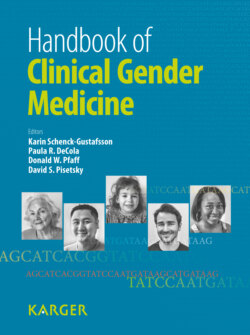Читать книгу Handbook of Clinical Gender Medicine - Группа авторов - Страница 91
На сайте Литреса книга снята с продажи.
Life Cycle Model of Stress
ОглавлениеLupien et al. [6] recently proposed that the consequences of chronic stress and/or trauma at different life stages depend on which brain regions are developing or declining at the time of the exposure. As illustrated in figure 1, stress in the prenatal period affects the development of the hippocampus, prefrontal cortex, and amygdala, leading to programming effects. The differential effects of postnatal stress differ according to environmental exposure; for instance, maternal separation during childhood generally leads to increased secretion of cortisol, whereas exposure to severe abuse is associated with decreased levels of cortisol. From the prenatal period onwards, all developing brain areas are sensitive to the effects of stress hormones; however, some areas undergo rapid growth during key critical windows. From birth to 2 years of age, the developing hippocampus is most vulnerable to the effects of stress. By contrast, exposure to stress from birth to late childhood leads to changes in amygdala volume, which continues to develop until the late 20s.
Fig. 1. The life cycle model of stress. Reproduced with permission of the Nature Publishing Group from Lupien et al. [6].
During adolescence, the hippocampus is fully organized, the amygdala continues to develop, and finally the frontal lobe undergoes important maturation. Consequently, stress exposure during this transition into adulthood can have major effects on the frontal cortex. Studies show that adolescents are highly vulnerable to stress because of pubertal changes in gonadic hormones and sensitivities of the hypothalamic-pituitary-adrenal axis that can persist into adulthood as potentiation/incubation effects. In adulthood and during aging, the brain regions that undergo the most rapid decline as a result of senescence are once again highly vulnerable to the effects of stress hormones. This leads to the manifestation of incubated effects from earlier life on the brain, known as manifestation effects or maintenance effects [6].
Lifelong brain changes ultimately diminish the organism’s ability to adapt, leading to subtle recalibrations in stress responsivity that could be used to detect disease trajectories [7]. According to the life cycle model of stress, regional volumes of these neurological structures in conjunction with biological signatures (e.g. hypercortisolism vs. hypocortisolism) can be used to predict differential risk profiles for specific psychopathologies (e.g. depression vs. PTSD) in adulthood as well as to inform when certain traumas might have occurred in early life [6]. While direct measurement of central nervous system substrates is costly and potentially invasive, indirect assessment using peripheral biomarkers routinely collected in blood draws can be used to infer AL levels. By interpreting this information in an alternative manner, the AL model proposes a temporal pathophysiological cascade useful for future early detection strategies for both physical and psychiatric morbidity.
